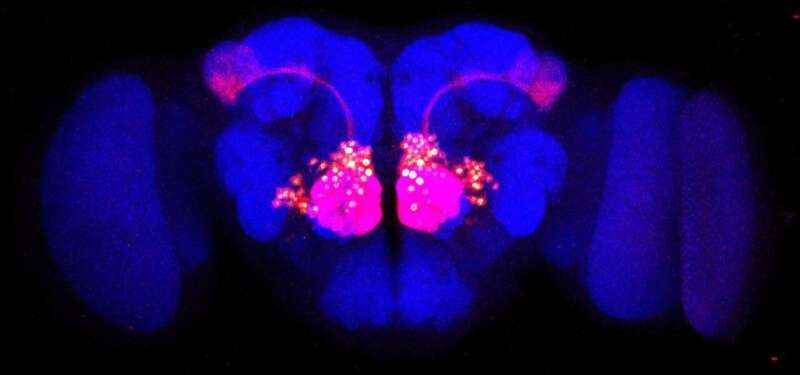Researchers look to the fruit fly to understand the human brain

The human nervous system is like a complex circuit board. When wires cross or circuits malfunction, conditions such as schizophrenia or bipolar disorder can arise.
For a long time, scientists have been working to zoom in and identify how brain circuits form so they can learn to rewire troublemaking neurons.
Now, researchers at Stanford led by professor of biology Liqun Luo and professor of bioengineering and of applied physics Stephen Quake have taken a significant step forward in that direction by making a detailed cell-by-cell gene blueprint of the fruit fly's olfactory neurons. Their work has been published in Cell.
The basic idea behind the research is to understand the neuronal cell types of the relatively simple fly brain, and to identify the molecules that direct the precise wiring of different types of neurons in the fly brain. Over time, researchers want to use a similar approach to study the far more complex cellular makeup of the human brain, and maybe one day even repair the miswiring in brain disorders.
Single-cell RNA sequencing
Reaching back into high school biology, remember that cells have DNA and RNA. DNA is the genetic code that represents the blueprint of an entire organism. The fruit fly, a model organism for the human because it shares approximately 75 percent of our known disease genes, has about 15,000 genes. Of course, not all genes are expressed all the time. Each individual cell expresses a specific subset of genes, which in turn make a specific set of proteins. Messenger RNA molecules carry the genetic codes to create, or express, whatever proteins may be required by any specific cell at any point in time.
The Stanford researchers focused on cells in the olfactory, or smelling, and sensing quadrants of the fly brain. The fruit fly is one of the most studied organisms in biology. Prior experimental research has proven the fly's olfactory system to be a clean and simple circuit, making it the ideal test bed for developing a new genetic technology to probe how brain circuits are wired up. The smell center of the fly brain has 50 types of central processing neurons that grow threadlike filaments to connect with 50 types of sensory neurons. Each connected pair of neurons allows the fruit fly to smell one group of odors, and in combination, the fruit fly can detect the myriad odors of the fruits in your kitchen.
To see the entire repertoire of genes expressed in these cells, the Stanford team used a method pioneered by Quake that enables researchers to sequence all the messenger RNA in a cell. The single cell sequencing technologies developed by Quake and his collaborators have become widely used and are the basis of international efforts to develop a comprehensive atlas of human and mouse cell types. But postdoctoral scholar Hongjie Li and PhD student Felix Horns tweaked the process to make it work for the fruit fly, which has small cells and a much smaller amount of messenger RNA per cell.
By combining Quake's single-cell RNA sequencing with Luo's detailed knowledge of the fruit fly's olfactory circuit, the team was able to create the first blueprint showing how specific gene/protein activity correlates with the biological wiring of at least one component of an organism's nervous system.
Defining a cell type
Ultimately, the researchers would like to create a blueprint for the human nervous system, but their first step has to be to identify the component cells of the human brain. This is particularly challenging because although cells can be defined by function, physiology, anatomy and gene expression, researchers have had a hard time unifying these properties. Two cells may have the same function but different physiologies. "People have been hopeful that single-cell RNA sequencing would help resolve this issue, but so far it hasn't been easy," said Luo.
Studying the fruit fly first has helped because over the past two decades, Luo and his lab have gotten to know the function, physiology and anatomy of the organism's olfactory system very well. Though researchers are still debating whether there are 1,000 or 10,000 cell types in the human brain, Luo said we already know the number of cell types in the fruit fly's olfactory system. That made this simple organism the ideal test bed to connect gene expression to the other pieces in the cell type puzzle and develop a process to ultimately study the human brain.
New insights
Though researchers are still a long way from that goal, their finding has already yielded some interesting insights into the minds of flies. For example, the researchers found that during development, when olfactory neurons are choosing connection partners, the gene expression between different neuronal types is different. But as fruit flies mature, gene expression patterns from different neuronal types become indistinguishable. "Once the brain is wired up, the fly doesn't need to express those genes that help them in choosing the connection partners," Horns said. "So there is less gene expression diversity in the adult flies."
The ultimate goal is to develop new and powerful tools for understanding the genetic blueprints that wire the human brain. "By further developing this approach, we hope to one day reverse-engineer and perhaps even repair defective circuitry in the human brain," said Li, whose interdisciplinary work on this project was supported by the Stanford Neurosciences Institute.
More information: Hongjie Li et al. Classifying Drosophila Olfactory Projection Neuron Subtypes by Single-Cell RNA Sequencing, Cell (2017). DOI: 10.1016/j.cell.2017.10.019
Journal information: Cell
Provided by Stanford University





















